
Lucky imaging
Encyclopedia
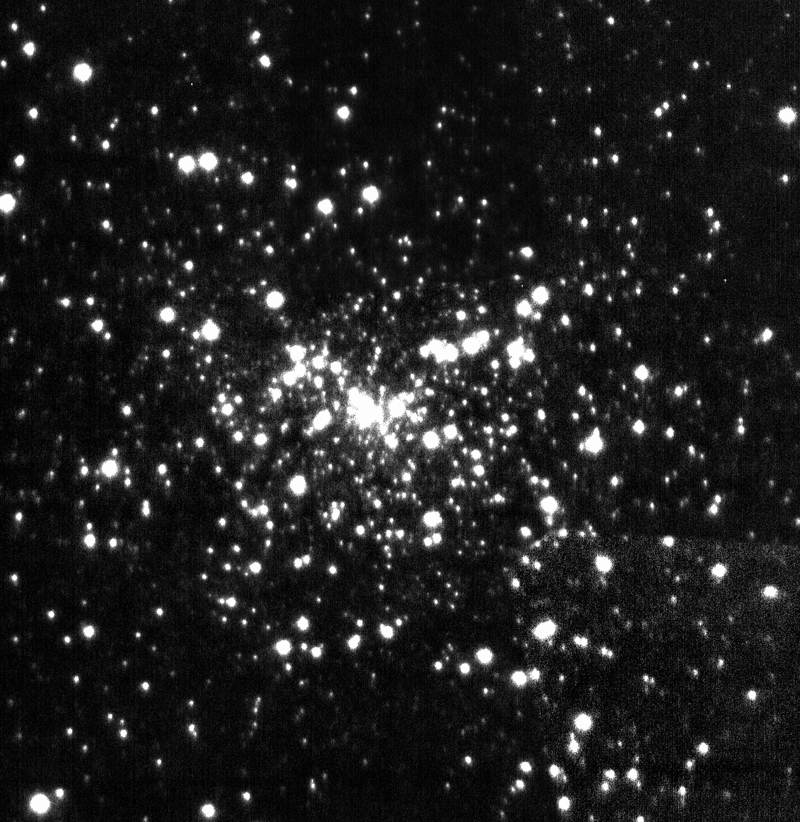
Speckle imaging
Speckle imaging describes a range of high-resolution astronomical imaging techniques based either on the shift-and-add method or on speckle interferometry methods...
used for astronomical photography. Speckle imaging techniques use a high-speed camera with exposure times short enough (100 ms or less) so that the changes in the Earth's atmosphere
Earth's atmosphere
The atmosphere of Earth is a layer of gases surrounding the planet Earth that is retained by Earth's gravity. The atmosphere protects life on Earth by absorbing ultraviolet solar radiation, warming the surface through heat retention , and reducing temperature extremes between day and night...
during the exposure are minimal.
With lucky imaging, those optimum exposures least affected by the atmosphere (typically around 10%) are chosen and combined into a single image by shifting and adding
Shift-and-add
The shift-and-add method is a form of speckle imaging commonly used for obtaining high quality images from a number of short exposures with varying image shifts. It has been used in astronomy for several decades, and is the basis for the image-stabilisation feature on some cameras...
the short exposures, yielding much higher resolution than would be possible with a single, longer exposure which includes all the frames.
Explanation
Images taken with ground based telescopeTelescope
A telescope is an instrument that aids in the observation of remote objects by collecting electromagnetic radiation . The first known practical telescopes were invented in the Netherlands at the beginning of the 1600s , using glass lenses...
s are subject to the blurring effect of atmospheric turbulence (seen to the human eye as the stars twinkling). Many astronomical imaging programs require higher resolution than is possible without some correction of the images. Lucky imaging is one of several methods used to remove atmospheric blurring. Used at a 1% selection or less, lucky imaging can reach the diffraction limit of even 2.5 m aperture telescopes, a resolution improvement factor of at least five over standard imaging systems.
Demonstration of the principle
The sequence of images below shows how lucky imaging works. From a series of 50,000 images taken at a speed of almost 40 images per second, five different long exposure images have been created. Additionally, a single exposure with very low image quality and another single exposure with very high image quality are shown at the beginning of the demo sequence.| Single exposure with very low image quality, not selected for Lucky Imaging. | ||
| Single exposure with very high image quality, selected for Lucky Imaging. | ||
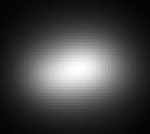 | The image shows the sum of all 50,000 images, which is almost the same as the 21 minutes (50,000/40 seconds) long exposure seeing limited image. It looks like a typical star image, slightly elongated. The full width at half maximum (FWHM) of the seeing disk is around 0.9 arcsec. | |
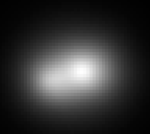 | The image shows the sum of all 50,000 single images but here with the center of gravity (centroid) of each image shifted to the same reference position. This is the tip-tilt Adaptive optics Adaptive optics is a technology used to improve the performance of optical systems by reducing the effect of wavefront distortions. It is used in astronomical telescopes and laser communication systems to remove the effects of atmospheric distortion, and in retinal imaging systems to reduce the... corrected, or image stabilized, long exposure image. It already shows more details - two objects - than the seeing limited image. | |
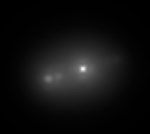 | The image shows the 25,000 (50% selection) best images added together with the brightest pixel in each image moved to the same reference position. In this image, we can almost see three objects. | |
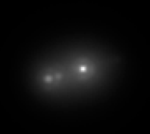 | The image shows the 5,000 (10% selection) best images added together with the brightest pixel in each image moved to the same reference position. The surrounding seeing halo is further reduced, an airy ring around the brightest object becomes clearly visible. | |
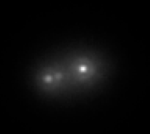 | The image shows the 500 (1% selection) best images added together with the brightest pixel in each image moved to the same reference position. The seeing halo is further reduced. The signal-to-noise ratio Signal-to-noise ratio Signal-to-noise ratio is a measure used in science and engineering that compares the level of a desired signal to the level of background noise. It is defined as the ratio of signal power to the noise power. A ratio higher than 1:1 indicates more signal than noise... of the brightest object is the highest in this image. |
The difference between the seeing limited image and the best 1% images selected result is quite remarkable: a triple system can be detected. The brightest component in the West is a V=14.9 magnitude M4V star. This component is the lucky imaging reference source. The weakest - tertiary - component a M7-M8 spectral type star. The distance of the system is about 45 pc. Airy rings can be seen, which indicate that the diffraction limit of the Calar Alto Observatory
Calar Alto Observatory
The Calar Alto Observatory is an astronomical observatory owned and operated jointly by the Max-Planck-Institut für Astronomie in Heidelberg, Germany, and the Instituto...
's 2.2m telescope was reached. The signal to noise ratio of the point sources increases with stronger selection. The seeing halo on the other side is more suppressed. The separation between the two brightest objects is around 0.55 arcsec and between the two faintest objects less than 0.15 arcsec. At a distance of 45 pc this corresponds to 6.75 times the distance between Earth and Sun, around 1 billion kilometers (109 km).
History
Lucky imaging methods were first used in the middle 20th century, and became popular for imaging planets in the 1950s and 1960s (using cine cameras, often with image intensifierImage intensifier
An image intensifier tube is a vacuum tube device for increasing the intensity of available light in an optical system to allow use under low light conditions such as at night, to facilitate visual imaging of low-light processes such as fluorescence of materials to X-rays or gamma rays, or for...
s). For the most part it took 30 years for the separate imaging technologies to be perfected for this counter-intuitive imaging technology to become practical. The first numerical calculation of the probability of obtaining lucky exposures was an article by David L. Fried
David L. Fried
David L. Fried is a scientist, best known for his contributions to optics. Fried described what has come to be known as Fried's seeing diameter, or r0 . The seeing diameter is effectively a limiting aperture due to atmospheric turbulence, and is found either empirically or statistically. The...
in 1978.
In early applications of lucky imaging, it was generally assumed that the atmosphere "smeared-out" or "blurred" the astronomical images. In this work, the FWHM
Full width at half maximum
Full width at half maximum is an expression of the extent of a function, given by the difference between the two extreme values of the independent variable at which the dependent variable is equal to half of its maximum value....
of the blurring was estimated, and used to select exposures. Later studies took advantage of the fact that the atmosphere does not "blur" astronomical images, but generally produces multiple sharp copies of the image (the point spread function
Point spread function
The point spread function describes the response of an imaging system to a point source or point object. A more general term for the PSF is a system's impulse response, the PSF being the impulse response of a focused optical system. The PSF in many contexts can be thought of as the extended blob...
has "speckles"). New methods were used which took advantage of this to produce much higher quality images than had been obtained assuming the image to be "smeared".
In the early years of the 21st century, it was realised that turbulent intermittency (and the fluctuations in Astronomical seeing
Astronomical seeing
Astronomical seeing refers to the blurring and twinkling of astronomical objects such as stars caused by turbulent mixing in the Earth's atmosphere varying the optical refractive index...
conditions it produced) could substantially increase the probability of obtaining a "lucky exposure" for given average astronomical seeing conditions.
.
Lucky Imaging and Adaptive Optics Hybrid Systems
In 2007 astronomers at Caltech and the University of CambridgeUniversity of Cambridge
The University of Cambridge is a public research university located in Cambridge, United Kingdom. It is the second-oldest university in both the United Kingdom and the English-speaking world , and the seventh-oldest globally...
announced the first results from a new hybrid Lucky Imaging and Adaptive Optics
Adaptive optics
Adaptive optics is a technology used to improve the performance of optical systems by reducing the effect of wavefront distortions. It is used in astronomical telescopes and laser communication systems to remove the effects of atmospheric distortion, and in retinal imaging systems to reduce the...
(AO) system. The new camera gave the first diffraction-limited resolutions on 5m-class telescopes in visible light. The research was performed on the 200 inch (5.08 meter) diameter aperture Palomar Hale telescope
Hale telescope
The Hale Telescope is a , 3.3 reflecting telescope at the Palomar Observatory in California, named after astronomer George Ellery Hale. With funding from the Rockefeller Foundation, he orchestrated the planning, design, and construction of the observatory, but did not live to see its commissioning...
.
The 200-inch Hale telescope with Lucky cam and adaptive optics pushed the telescope near to its theoretical resolution, achieving up to 0.025 arc seconds for certain types of viewing. Compared to Space Telescopes like the 2.4 m Hubble, the system still has some drawbacks including narrow field of view
Field of view
The field of view is the extent of the observable world that is seen at any given moment....
for crisp images (typically 10" to 20"), airglow
Airglow
Airglow is the very weak emission of light by a planetary atmosphere. In the case of Earth's atmosphere, this optical phenomenon causes the night sky to never be completely dark .-Development:The airglow phenomenon was first identified in 1868 by Swedish scientist...
, and electromagnetic frequencies blocked by the atmosphere (see Extinction (astronomy)
Extinction (astronomy)
Extinction is a term used in astronomy to describe the absorption and scattering of electromagnetic radiation by matter between an emitting astronomical object and the observer. Interstellar extinction—also called Galactic extinction, when it occurs in the Milky Way—was first...
).
 |
Lucky Imaging + AO image of the core of the M13 globular cluster. The best 10% of the frames taken were aligned and summed to make this final very-high-resolution (40 milli-arcsecond) image. Approximately 1-arcsecond diameter field. |
 |
Hubble Space Telescope ACS-camera image of the same field in a filter passing 660 nm light. The stars in the Lucky Imaging + AO image are much better separated, although the Hubble image is longer-exposure and so shows some fainter stars. |
When combined with an AO system Lucky Imaging selects the periods when the turbulence that the adaptive optics system must correct is reduced. In these periods, lasting a small fraction of a second, the correction given by the AO system is sufficient to give excellent resolution with visible light. The Lucky Imaging system sums the images taken during the excellent periods to produce a final image with much higher resolution than is possible with a conventional long-exposure AO camera.
This technique is applicable to getting very high resolution images of only relatively small astronomical objects, up to 10 arcseconds in diameter, as it is limited by the precision of the atmospheric turbulence correction. It also requires a relatively bright 14th-magnitude star in the field of view on which to guide. Being above the atmosphere, the much more expensive Hubble Space Telescope
Hubble Space Telescope
The Hubble Space Telescope is a space telescope that was carried into orbit by a Space Shuttle in 1990 and remains in operation. A 2.4 meter aperture telescope in low Earth orbit, Hubble's four main instruments observe in the near ultraviolet, visible, and near infrared...
is not limited by these concerns and so is capable of much wider-field high-resolution imaging.
Popularity of technique
Both amateur and professional astronomerAstronomer
An astronomer is a scientist who studies celestial bodies such as planets, stars and galaxies.Historically, astronomy was more concerned with the classification and description of phenomena in the sky, while astrophysics attempted to explain these phenomena and the differences between them using...
s have begun to use this technique. Modern webcam
Webcam
A webcam is a video camera that feeds its images in real time to a computer or computer network, often via USB, ethernet, or Wi-Fi.Their most popular use is the establishment of video links, permitting computers to act as videophones or videoconference stations. This common use as a video camera...
s and camcorder
Camcorder
A camcorder is an electronic device that combines a video camera and a video recorder into one unit. Equipment manufacturers do not seem to have strict guidelines for the term usage...
s have the ability to capture rapid short exposures with sufficient sensitivity for astrophotography
Astrophotography
Astrophotography is a specialized type of photography that entails recording images of astronomical objects and large areas of the night sky. The first photographs of an astronomical object were taken in the 1840s, but it was not until the late 19th century that advances in technology allowed for...
, and these devices are used with a telescope and the shift-and-add
Shift-and-add
The shift-and-add method is a form of speckle imaging commonly used for obtaining high quality images from a number of short exposures with varying image shifts. It has been used in astronomy for several decades, and is the basis for the image-stabilisation feature on some cameras...
method from speckle imaging
Speckle imaging
Speckle imaging describes a range of high-resolution astronomical imaging techniques based either on the shift-and-add method or on speckle interferometry methods...
(also known as image stacking
Shift-and-add
The shift-and-add method is a form of speckle imaging commonly used for obtaining high quality images from a number of short exposures with varying image shifts. It has been used in astronomy for several decades, and is the basis for the image-stabilisation feature on some cameras...
) to achieve previously unattainable resolution. If some of the images are discarded, then this type of video astronomy is called lucky imaging.
Many methods exist for image selection, including the Strehl
Strehl ratio
The Strehl ratio, named after the German physicist and mathematician Karl Strehl , is a measure for the optical quality of telescopes and other imaging instruments...
-selection method first suggested by John E. Baldwin
John E. Baldwin
John Evan Baldwin FRS has worked at the Cavendish Astrophysics Group since 1954. He played a pivotal role in the development of interferometry in Radio Astronomy, and later astronomical optical interferometry and lucky imaging...
from the Cambridge group and the image contrast selection used in the Selective Image Reconstruction method of Ron Dantowitz. The recent development of EMCCDs has allowed the first high quality lucky imaging of faint objects.
Due to the large amounts of data that must be processed in order to increase systematic gain, Lucky imaging is amenable to distributed computing
Distributed computing
Distributed computing is a field of computer science that studies distributed systems. A distributed system consists of multiple autonomous computers that communicate through a computer network. The computers interact with each other in order to achieve a common goal...
methods. Semi-automated image processing methods like Galaxy Zoo
Galaxy Zoo
Galaxy Zoo is an online astronomy project which invites members of the public to assist in the morphological classification of large numbers of galaxies. It is an example of citizen science as it enlists the help of members of the public to help in scientific research. An improved version—Galaxy...
implement can be extended and fully automated for distributed computing systems like BOINC.
Alternative methods
Other approaches that can yield resolving power exceeding the limits of atmospheric seeingAstronomical seeing
Astronomical seeing refers to the blurring and twinkling of astronomical objects such as stars caused by turbulent mixing in the Earth's atmosphere varying the optical refractive index...
include adaptive optics
Adaptive optics
Adaptive optics is a technology used to improve the performance of optical systems by reducing the effect of wavefront distortions. It is used in astronomical telescopes and laser communication systems to remove the effects of atmospheric distortion, and in retinal imaging systems to reduce the...
, interferometry, other forms of speckle imaging
Speckle imaging
Speckle imaging describes a range of high-resolution astronomical imaging techniques based either on the shift-and-add method or on speckle interferometry methods...
and space-based telescopes such as NASA's Hubble Space Telescope
Hubble Space Telescope
The Hubble Space Telescope is a space telescope that was carried into orbit by a Space Shuttle in 1990 and remains in operation. A 2.4 meter aperture telescope in low Earth orbit, Hubble's four main instruments observe in the near ultraviolet, visible, and near infrared...
.
External links
- Amateur lucky imaging
- The Cambridge University Institute of Astronomy lucky imaging website
- Results from Lucky Imaging combined with Adaptive Optics, from Caltech
- Detailed PhD thesis about astronomy with Lucky Imaging, from 2006
- Lucky Imaging with Astralux at the 2.2m Calar Alto telescope
- Details of the Calar Alto Lucky imaging instrument
- Details of the LuckyCam instrument at the Nordic Optical Telescope
- BBC News article: UK stargazers enjoy 'Lucky' break
- BBC News article: 'Clearest' images taken of space
- Lucky imaging using gen 3 intensifier tubes

